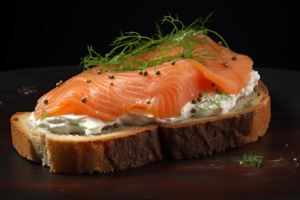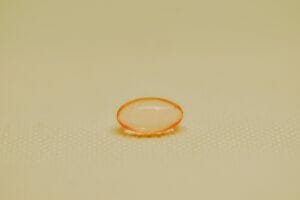With the numerous health benefits associated with omega-3 fatty acids, it’s no wonder why it has become a popular nutrient in diets worldwide. However, with so many different sources of fish oil (omega-3), finding the right food source can be overwhelming and confusing for many people. In this article, we will explore various natural food sources of fish oil that you can incorporate into your diet to ensure optimal intake levels of omega-3 while providing valuable nutrients for your body. So sit back and learn how to get the most out of your diet through natural sources!
Fatty Fish: The Best Source of Omega-3
Fatty fish are the best source of omega-3 and an essential part of a balanced diet. Omega-3 fatty acids are crucial for maintaining a healthy body, including brain function, reducing inflammation, and maintaining heart health. These essential fats cannot be produced by humans; therefore, it’s necessary to consume them through our diet.
Fatty fish such as salmon, sardines, mackerel, tuna, and trout have the highest amounts of omega-3s. Experts recommend consuming at least two servings per week or taking supplements if you’re not getting enough from your diet.
One benefit of incorporating fatty fish into your diet is that it’s versatile in cooking methods: broiling, baking or grilling with some herbs and spices can make a delicious addition to any meal plan.
When shopping for these types of fish at the supermarket or grocery store be mindful as they can contain higher levels of mercury due to their dietary habits requiring consumption lower in food chain prey /plankton which typically has more exposure hazardous chemicals persistent from pesticides or plastics pollution in oceans over time..
Plant-Based Sources: A Vegetarian’s Guide to Omega-3
As many people aim to adopt plant-based eating habits, finding alternative sources of omega-3 has become a crucial part of maintaining a balanced diet. Luckily, there are various nutritious foods that can provide enough quantities of this essential fatty acid without having to consume fish oil. For example, flaxseed and chia seeds are both excellent sources of alpha-linolenic acid (ALA), which is then converted into EPA and DHA in the body.
In addition to plant-based oils such as flaxseed or algae oils encapsulated for supplements, other food options include nuts like walnuts or pecans, leafy greens such as kale or spinach, and seaweed like nori. One effective way to incorporate these items into daily meals is by adding them to smoothies or salads – it’s an easy way to increase nutrient density while also diversifying your palate! By exploring more vegetarian-friendly substitutes for omega-3s, individuals can maintain their health goals while adhering to ethical dietary beliefs.
The Benefits of Eating Nuts and Seeds for Omega-3
Nuts and seeds are excellent sources of omega-3 fatty acids that provide numerous health benefits for the body. These healthy fats play an essential role in reducing inflammation, improving heart health, optimizing brain function, and promoting optimal overall wellness. Incorporating nuts and seeds into your diet will not only benefit your omega-3 intake but also provides other valuable nutrients such as fiber, protein, vitamins, and minerals.
Walnuts, flaxseeds, chia seeds, pumpkin seeds are some examples of nuts and seeds that pack a powerful punch of omega-3s. A small serving size packed with these superfoods can help meet daily requirements for Omega – 3 therefore reducing the risk factors associated with various chronic illnesses by maintaining optimal levels in regular consumption quantity. Eating more natural wholefood based foods like those mentioned ensures investment towards long term physical health providing well-rounded advantages to enriched mental stability while keeping you feeling full longer due to its high oil content ultimately supporting weight management strategies as well!
How to Incorporate Omega-3 into Your Breakfast Routine
Incorporating omega-3 into your breakfast routine is a great way to start the day off on a healthy note. One easy option is to add flaxseed or chia seeds to your yogurt, oatmeal, or smoothie. These tiny powerhouses are rich in alpha-linolenic acid (ALA), one type of omega-3 fatty acid that can be converted by the body into EPA and DHA.
Another delicious way to get more omega-3s at breakfast is by including fatty fish like salmon, mackerel, or sardines in your morning meal. Smoked salmon on toast with cream cheese and capers or a frittata with canned wild-caught salmon are both tasty options that provide plenty of healthful nutrients as well as protein.
 By incorporating these simple modifications into your breakfast routine, you can boost your omega-3 intake while starting your day off strong.
By incorporating these simple modifications into your breakfast routine, you can boost your omega-3 intake while starting your day off strong.
With so many natural sources available, it’s easier than ever before to ensure optimal intake levels of this vital nutrient!
Don’t Forget About Seafood: Other Sources of Fish Oil
Don’t forget about seafood! It’s important to keep in mind that fish is not the only source of omega-3 fatty acids. Other types of seafood such as shrimp, crab, and clams also contain this vital nutrient. These options provide a variety of different tastes and textures to your diet while still ensuring optimal intake levels of omega-3.
Additionally, nuts and seeds are another great source of omega-3 fatty acids. Walnuts, chia seeds, flaxseeds, and hemp seeds all pack a punch when it comes to this nutrient. They can easily be added into meals like oatmeal or smoothies for an extra boost.
Keep in mind that incorporating these other sources into your diet can help prevent getting bored with just one type of food (fish). It’s essential to remember that there are plenty of tasty ways to get enough nutrients without sacrificing taste preferences!
Supplements vs Natural Sources: Which is Better for Omega-3?
When it comes to obtaining omega-3 fatty acids, there are two main options: supplements or natural sources. Supplements can offer a quick and convenient way to get your daily dose of omega-3s, but many experts say that natural sources may be the superior choice. This is because foods like fatty fish, nuts, and seeds contain not only high levels of omega-3s, but also other important nutrients such as protein and fiber.
In addition to potential health benefits beyond just omega-3 content, natural sources are often less processed than supplements and therefore may be easier for your body to absorb. However, it’s worth noting that getting enough omega-3 through diet alone can be challenging for some people – particularly those who don’t consume much seafood or have dietary restrictions like veganism – in which case supplements may be necessary. Ultimately, both methods have their pros and cons – choosing the right one for you will depend on individual needs and preferences.

Tips for Cooking with Omega-3 Rich Foods
Cooking with omega-3 rich foods can be a great way to ensure that you are receiving the many benefits of this important nutrient. When cooking with fish, it’s best to choose types of fish that are high in omega-3s such as salmon, mackerel, and tuna. Grilling or roasting these fish can help preserve their natural flavors while also adding a healthy dose of omega-3s to your meal.
In addition to seafood, there are other natural sources of omega-3s that can easily be incorporated into your diet. For example, flaxseed oil and chia seeds contain high levels of alpha-linolenic acid (ALA) which is converted into EPA and DHA – the two main types of omega-3 fatty acids found in fish. Adding these ingredients into smoothies or baked goods can help increase your intake without much added effort.
It’s important to keep in mind that when cooking with oils containing omega-3 fatty acids, they should not be heated too much as this may decrease their nutritional value. Additionally, storing foods rich in these healthy fats properly will ensure they maintain their freshness so you receive all the benefits they have to offer!
In Closing:
Omega-3 fats are essential fatty acids that play an important role in our bodies. Fish oil supplements are commonly used to get omega-3s, but they can also be obtained naturally through diet. Oily fish like salmon and shellfish are seafood sources rich in omega-3s. Three ounces of these foods high in omega-3s can provide up to 500 milligrams of eicosapentaenoic acid (EPA) and docosahexaenoic acid (DHA).

For vegetarians or those who don’t eat fish, plant-based sources of omega-3s are a viable alternative. Plant foods such as flaxseeds and Brussels sprouts contain a type of omega-3 called ALA. The body can convert ALA into small amounts of DHA and EPA. A tablespoon of flaxseed oil contains high amounts of ALA per tablespoon, while a tablespoon of canola oil is also high in ALA.
Fortified foods, like omega-3-enriched eggs, also provide DHA and EPA. Fortifying foods with omega-3 and omega-6 has become a popular way to meet your omega-3 needs. For instance, some juices are fortified with DHA and EPA, with each cup offering a significant portion of the daily value.
A balanced diet of seafood, plant foods, and fortified foods can help maintain healthy omega-3 levels and prevent cognitive decline. Remember that your body needs a balanced intake of omega-3 and omega-6 for optimal health. Hence, including a variety of foods high in omega-3, such as canola oil, is essential to get your omega-3s, and to benefit from their protective effects.
FAQ:
Q: What are omega-3s?
A: Omega-3s are a type of polyunsaturated fatty acid that are considered essential because our bodies don’t produce them. They play a crucial role in brain function and are important for heart health.
Q: Why are omega-3 fatty acids important?
A: Omega-3 fatty acids are important because they are essential for our bodies to function properly. They play a crucial role in brain function and are important for heart health, among other benefits.
Q: What foods are high in omega-3s?
A: Foods high in omega-3s include fatty fish like salmon, sardines, and mackerel, as well as plant-based sources like flaxseed, walnuts, and alga. Some foods, such as eggs, yogurt, and milk, are also fortified with omega-3s.
Q: Can vegetarians get enough omega-3s?
A: Yes, vegetarians can get enough omega-3s through plant-based sources like flaxseed, walnuts, and alga. It is important for vegetarians to pay attention to their omega-3 levels and consider taking an omega-3 supplement if necessary.
Q: How much omega-3 do I need every day?
A: The amount of omega-3 needed every day varies depending on age, gender, and overall health. However, most experts recommend consuming at least 250-500 milligrams of EPA and DHA, the types of omega-3s found in seafood sources, per day.
Q: Are there any foods I should avoid if I want to increase my intake of omega-3s?
A: Foods high in omega-6 fatty acids, such as processed foods and vegetable oils like corn and soybean oil, should be limited because they can interfere with the body’s ability to absorb omega-3s.
Q: What are the benefits of omega-3s?
A: Omega-3s have a number of important health benefits, including reducing inflammation, lowering blood pressure, improving brain function, and reducing the risk of chronic diseases like heart disease, cancer, and arthritis.
Q: Do I need to take an omega-3 supplement?
A: It is possible to get enough omega-3s through diet alone, but some people may benefit from taking an omega-3 supplement. This is particularly true for those who don’t eat fish or other seafood sources of omega-3s.
Q: Are there any risks associated with taking an omega-3 supplement?
A: Taking too much of an omega-3 supplement can increase the risk of bleeding and may interact with certain medications. It is important to talk to your healthcare provider before taking any supplements.
Q: How can I incorporate more omega-3 foods into my diet?
A: Some easy ways to incorporate more omega-3 foods into your diet include adding chia seeds or flaxseed to smoothies or oatmeal, snacking on walnuts or almonds, and incorporating fatty fish into your meals a few times a week.
Q: Do plant-based sources of omega-3s contain all three types?
A: Plant-based sources of omega-3s, such as flaxseed and alga, contain ALA omega-3, which the body can convert into EPA and DHA. However, the conversion rate is generally low, so it is important to also consume seafood sources of omega-3s or take a supplement if necessary.



 How Can I Increase my Fish Oil (Omega-3) Fast
How Can I Increase my Fish Oil (Omega-3) Fast
